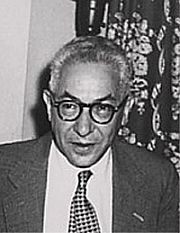-
(b.) -1898 July 29(d.)1988
Bio/Description
A Galician-born American physicist and Nobel laureate recognized in 1944 for his discovery of nuclear magnetic resonance, he was born into a traditional Jewish family in Ryman?w, Galicia, Austria-Hungary (now Poland), and was brought to the United States as a child the following year. He was awarded a Bachelor of Science in Chemistry degree from Cornell University in 1919, continuing his studies at Columbia University and received his Ph.D. in 1927. A fellowship enabled him to spend the next two years in Europe working with such eminent physicists as Niels Bohr, Werner Heisenberg, Wolfgang Pauli and Otto Stern. He then joined the Columbia faculty and never left. In 1930 he conducted investigations into the nature of the force binding protons to atomic nuclei. This research eventually led to the creation of the molecular-beam magnetic-resonance detection method, for which he was awarded the Nobel Prize for Physics in 1944. In 1940 he was granted leave from Columbia to work as Associate Director of the Radiation Laboratory at the Massachusetts Institute of Technology on the development of radar and the atomic bomb. Some say that he reluctantly agreed to serve as a visiting consultant who would come and go from Los Alamos, where he was one of the very few exceptions to the strict security rules there. Having been a student with Oppenheimer and maintained a close and mutually respectful relationship, he was asked by General Leslie Groves, who made a special effort to bring him out to Los Alamos for the days leading up to the Trinity test, so that he could help Oppenheimer maintain his sanity under such intense pressure. The scientists working on Trinity set up a betting pool for the results of the test, with predictions ranging from total dud to 45 kilotons of TNT equivalent (KT). His guess of 18 KT proved to be the closest to the actual yield of 18.6 KT, despite his having made the guess by default (it was the only choice left by the time he arrived), and he won the pool. After the war he continued his research, which contributed to the inventions of the laser and the atomic clock. He was also one of the founders of both Brookhaven National Laboratory and CERN, and served as U.S. President Harry S. Truman's second Science Advisor. He chaired Columbia's physics department from 1945 to 1949, a period during which it was home to two Nobel Laureates (himself and Enrico Fermi) and eleven future laureates, including seven faculty (Polykarp Kusch, Willis Lamb, Maria Goeppert-Mayer, James Rainwater, Norman Ramsey, Charles Townes and Hideki Yukawa), a research scientist (Aage Bohr), a visiting professor (Hans Bethe), a doctoral student (Leon Lederman) and an undergrad (Leon Cooper). When Columbia created the rank of University Professor in 1964, he was the first to receive such a chair. He retired from teaching in 1967 but remained active in the department and held the title of University Professor Emeritus and Special Lecturer until his death in 1988. He served as the U.S. Representative to the NATO Science Committee at the time the term 'Software Engineering' was coined. While serving in that capacity, he bemoaned the fact that many large software projects were delayed. This prompted several discussions that led to the formation of a Study Group that organized the first conference on Software Engineering. He is the recipient of The International Center in New York's Award of Excellence as well as the 1967 Atoms for Peace Award. In 1985 he was awarded the Public Welfare Medal from the National Academy of Sciences. He also served on the board of trustees for Science Service, now known as Society for Science & the Public, from 1956-1959. Among his publications are: (1960). ?My life and times as a physicist?;. Claremont College. pp. 55; and (1969). ?Oppenheimer: The Story of One of the Most Remarkable Personalities of the 20th Century?, Scribner's, with Robert Serber, Victor F. Weisskopf, Abraham Pais, and Glenn T. Seaborg. In ?Turing?s Cathedral? by George Dyson it is noted, "An even stronger minority addendum, signed by Enrico Fermi and Isidor Rabi, added that ?It is necessarily an evil thing considered in any light.? "
-
Date of Birth:
1898 July 29 -
Date of Death:
1988 -
Gender:
Male -
Noted For:
Co-founder of CERN; (the World Wide Web began as a CERN project called ENQUIRE) and his comments made while he served as the U.S. Representative to the NATO Science Committee prompted several discussions that led to the formation of a Study Group that organized the first conference on Software Engineering -
Category of Achievement:
-
More Info:


